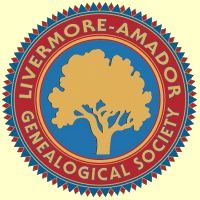
The Livermore Roots Tracer
Volume XXIII Number 1
February 2003
Editors: Debbie Pizzato, Vicki Renz and Mildred Kirkwood
 |
The Livermore Roots TracerVolume XXIII Number 1 February 2003 Editors: Debbie Pizzato, Vicki Renz and Mildred Kirkwood |
The Roots Tracer is a quarterly publication with articles of interest to the genealogist. Members are encouraged to submit articles of general interest. Queries are free. The Roots Tracer is published in February, May, August and November. The deadline for each quarterly is the 15th of the previous month. Submissions must contain the name of the submitter, as well as the name of the author, publication and date of any published article that is being quoted. Send material to: The Roots Tracer, P. O. Box 901, Livermore, CA 94551-0901 or E-mail: rootstracer@l-ags.org

2002 Membership Chair Kaye
Strickland
2003 Membership Chair Jane Southwick
| Marilyn Cutting | Diane Kolb | Barbara Huber |
| Cheryl Lacombe | David Keller | Pamela Lewis |
| Don Meeker | Wilma Molzahn | Carolyn Ristau |
| Edward Toy | Daniel Williams |
| Individual | 140 |
Memberships | 140 |
Individuals |
| Family | 37 |
Memberships | 74 |
Individuals |
| Life Memberships | 9 |
Memberships | 12 |
Individuals |
| Benefactors | 5 |
Memberships | 8 |
Individuals |
| Honorary/Charter | 5 |
Memberships | 5 |
Individuals |
| Honorary | 2 |
Memberships | 2 |
Individuals |
| Totals | 199 |
Memberships | 241 |
Individuals |
Each year we recognize in the Roots Tracer those members who support the society at the Benefactor ($40) or Sponsor ($100) level. So far for 2003 the following have renewed as Benefactors:
| Lois Barber | Dick and Wanda Finn | William and Virginia Loewe | Rhett Williamson |
 President's Message
President's Message President Dick Finn
What a great year we had at L-AGS. I look forward to 2003 being even better. Last year the huge Schellens Project, under the leadership of David Abrahams, completed the indexing of the Schellen notebooks for Alameda County. Great job folks. At the Pleasanton Library, work was done organizing items in a more useful way. Thanks to George Anderson and his crew of hard workers!
Another project we had a lot of fun with was the Lyster Project. What started out as a small query turned out to be a very large project in which a number of our members were involved. With information and a query about the Lawrence Lyster family of 1850s Dublin, California, from a James Lyster of London, we went on to gather more information. Mr. Lyster flew from England to meet with us and see the sites where his relatives had lived and worked. We have printed a book documenting what has been found so far. More information keeps coming in, so the project is not over yet.
But, we have other projects that we could use help with. We would like to expand the
hours that we have a genealogy docent at the Pleasanton Library. We would like to finish
and update work done on valley burial records and gravestone surveys. We would like to
index all births, marriages, and deaths in the Livermore-Amador Valley before 1905. We
have a number of other projects that we are thinking about. If you can help with any of
these projects or think of others we might be involved in, please contact any board
member.
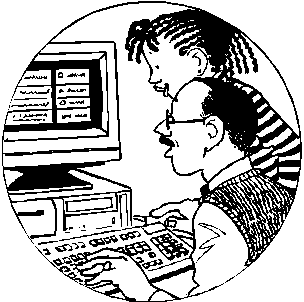
The L-AGS Family Tree Maker (FTM) Focus Group meets (during the school year) the first Thursday of the month at 7:30 p.m. at the Livermore Adult Education Facility (formerly the Sonoma Avenue School), Room 8 (note change), 543 Sonoma Avenue, Livermore. URL for a map to the school: http://www.L-AGS.org/sonoma.html.
We are primarily a group of FTM users who discuss problems and solutions, share successes, answer questions, and in general help each other with the Family Tree Maker software. At recent meetings we have talked about using shortcuts in FTM to input data, generating charts that show specific information and generations, showing some of the work we have done using FTM including producing our own low cost family history books, and the pros and cons of the newest version of FTM.
All persons interested or potentially interested in Family Tree Maker are invited to
attend. For information on our group, please call Dick Finn at 925-447-9652 or e-mail him
at president@L-AGS.org or George Anderson at
925-846-4265 or
webmaster@L-AGS.org. Contact Dick or George for
information about topics to be discussed. Visitors are welcome and there is no charge to
attend. Bring your questions, comments, and handbook and if you have a laptop with FTM
installed, you might bring it.
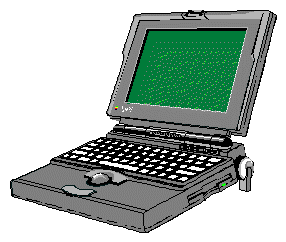
The CIG meets at 7:30 p.m. on the fourth Thursday of each month (except November and December) at the Livermore Adult Education Facility (formerly Sonoma Avenue School), 543 Sonoma Avenue, Livermore.
The purpose of the group is to assist members with computer related problems and share advice, information, and horror stories. Last year we had programs on computer security, identity theft, family history videos and scanning pictures. In the future we hope to have programs on search engines, paid-subscription services, drawing programs, more on scanning, digital cameras and storage-organization techniques. Members are encouraged to suggest topics of interest, and suggestions for speakers are always welcome. Any genealogical computer related subject from software to hardware to web sites is appropriate.
Members with computer problems are encouraged to discuss their problems, and may call one of the mentors listed in the Members handbook or send a request for help (or a solution) to CIG@L-AGS.org.
For information on CIG please e-mail Jim Lathrop computer@L-AGS.org,
George Anderson webmaster@L-AGS.org, Dick Finn president@L-AGS.org or call Jim at 443-4640, George
at 846-4265, or Dick at 447-9652.

After some bumps in the road the transcribing of the old Alameda County death records for the Pre- 1905 California Death Indexing Project is back underway with new leadership. The Indexing Project was started in San Diego County in mid-2001. There are now over twenty-four California county death indexes on RootsWeb. Additional county records are being transcribed, and other county records will be ordered pending funding. I expect several new indexes will be added to the web site in the next month. When finished, this will be a great aid to those looking for pre-1905 California records (it was about 1905 that the state took over control of records - before that it was up to each county).
We have found a new source of information and we hope that we can soon get to work. For
more information, and to use the records that have been transcribed, go to http://www.rootsweb.com/~cabf1905.
From: Dick Finn
Question - from Millie Starr, Genealogical Society of Stanislaus County
Many people are working on the pre 1905 death records. Are these exempt from the regulations of S.B. 1614 because they are not part of the State Vital Statistics or are these also to be restricted? It is my desire to publish these in our newsletter during the latter part of next year, but need to know that I won't end up in jail for doing so. Any help as to the official point of view would be greatly appreciated.
Answer - from Iris Carter Jones, President, Genealogical & Historical Council of Sacramento Valley
This is exempt. The information you already have and the work you have done are your work product, and not covered under the bill. That was one of the things we did win on. They did want to prevent all use in regards to the maiden names and social security numbers. But, we forced them to remove that penalty language.
I am curious, what was the source you folks used for the information? Did you get them from the State? The State's CDs? The Counties?
You know that there may be future attempts to prevent us from using information. So, for my information, let me know how you got your sources. Then I can keep an eye on what they are doing and hopefully we can prevent any further erosion of our access to our historic records.
Millie:
Thanks for the prompt response. May I share this with others involved in this project?
Our source is an LDS film that has births, deaths and marriages, 1873 to 1905. I thought perhaps because this was not under the ownership of the state dept. of vital stats, it would be exempt.
Iris:
I know about that film, but what I don't know is if it was originally done by the state or county recorders. If counties did it, much of their stuff would fall under the opuses (sic)of the State. But because it is pre-1905, I don't think there is any way the State could or even would try to prevent its use. It really isn't the Dept. of Health rank and file that want the records withheld. It is a political thing. Pre-1905 does not make for good press.
Yes, you may share what I said. And please keep me up to date on your project. I also
edit the Council newsletter and folks would love to hear of your work.

If you have an ancestor who was a Civil War Veteran, you can purchase a brick with his name, unit and state engraved on it. It will be added to the National Civil War Memorial being built in Gettysburg, PA. More information is available at http://www.nationalcwmemorial.org/index.htm
FROM: The Napa Valley Genealogical & Biographical Society Winepress, Vol. 28,
No. 10, October 2002.

Reprinted with permission from Family Tree Magazine E-mail Update, copyright 2002, F&W Publications, Inc. To subscribe to this free weekly e-mail newsletter, go to http://www.familytreemagazine.com/newsletter.asp
For a free sample copy of the printed Family Tree Magazine, America's #1 family history magazine, go to http://www.familytreemagazine.com/subscribe_mag.html.
The federal censuses have been taken every 10 years and began in 1790 (1791 for Vermont). Due to privacy laws, only census records 72 years and older are available for open research. Each census has an "official date" that should always be noted. The census taker, regardless of what day he or she recorded the information, was to list the occupants of any given household on the official date of that year's census. The official dates for each year to 1930 are listed below:
This means that a person born on April 20, 1910 shouldn't be listed in the 1910 census. The enumerator was to list only those people living in the household on April 15, 1910. In some cases it took months for the enumerator to visit every household and record the data. In the early census years (1790 to 1840), the enumerators were allowed anywhere from nine to 18 months to complete their tasks. In 1850, 1860 and 1870, they were allowed only five months to record all of the residents and from 1880 to 1920, only one month. Some enumerators followed the rules strictly, while others did not.
Excerpted from "The Genealogist's Question and Answer Book" by Marcia Yannizze Melnyk, $18.99. Reprinted here with permission from the publisher, Betterway Books. Available in bookstores or online at http://www.familytreemagazine.com/store/display.asp?id=70528.

Jill Williams, Ramsgate, Kent, England, via Richard Finn, Livermore, CA, used with permission.
This is a most amazing story. It just goes to show that we should always be on the search for anything that might be of interest. It will be interesting to find out where the Bible has been all these years. And how it got there. Dick Finn
Jill was 12 years old, living in Hougham, England in 1956 when her Sunday school teacher gave her a small bible. Jill wrote her name down in the bible, next to her teacher's name, Miss Jeavens. Even though Jill's family had moved 13 times in 16 years, she had kept track of the bible, never losing it, until she left home. "When I left home for the last time, I didn't take all of my belongings and my stepfather threw my bible and others things away."
Forty-two years later, Jill's brother called her and said he had something for her. He
is fourteen years younger than Jill and had no knowledge of the missing bible. He had been
browsing through a charity shop in Canterbury, England. "He just happened to pick the
bible up and look inside where he saw my name in my handwriting. He bought the bible
saying, 'just in case you wanted it.' It has been well looked after and on the inside
cover it is stamped, Emmanuel Hall, Brompton. Please do not take this away." Jill is
now trying to find out what Emmanuel Hall is and where her bible has been.

A family name is very important. After all, it ties you to your immediate family and, in most cases, some of your ancestors. It gives you a sense of who you are. It is not surprising then, that just about anyone starting on their genealogy places great emphasis on finding their family name in the various documents such as census records, birth records, etc. If that name cannot be found, either because of a name change, a misspelling or a misinterpretation, there is, of course, some frustration. Unfortunately, in some cases, the pursuit is dropped because of this frustration. The pleasure of working the genealogy puzzle is lost because one piece of the puzzle, the family name, seems to be missing. If, instead, focus is placed on the name as a puzzle in itself, they may find that working on it can be quite satisfying and can open many avenues to explore.
I was born with a rather unusual surname. Other than my siblings and a few cousins, I knew of no other kids with the same surname. Later in life, I did find there were three or four other families with the same name but more on that later. In various conversations with my dad concerning our name and where it came from, he said he had heard it came from northern Germany and that it might have been changed from something like Geise or Giese, but he wasn't sure. In any case, the topic wasn't about to capture his attention for very long. He had been born Geasa and that name had served him well enough. Many years later when the genealogy bug finally bit me, I found in talking to my Geasa cousins that they knew as little about the name as I did.
One older cousin, a lady some 18 years my senior, said she believed the name had been changed, possibly from Gieser, since that was the name on her father's birth certificate. She also said she had heard our grandfather, William Geasa, was born in Brooklyn and that he was a twin. She had heard conversations referring to him and the twin. She recalled hearing that our great-grandfather was also named William, that he had his own tugboat and our great-grandmother's name was Catherine.
After gathering the birth certificates of my father's three oldest siblings, including the cousin's father and finding Gieser as the name on all three, I was sure that was the original name. However, after finding the birth certificates for several of the younger children with the name recorded as Geasa and finding no indication of a legal name change, I looked at the first three certificates again. I then realized the same doctor had delivered the first three children and a change of doctors was accompanied by a change in the name.
Without much confidence now in Gieser as the original name, I moved on to Brooklyn to see if I could find anything there. I had found the 1900 Federal Census for my father's family and from it found the grandfather's birth year listed as 1863. The 1870 Federal Census looked like a good starting point.
The 1870 census yielded neither a William Geasa nor a William Gieser. I did however find a suspect, a William Gesse, a seaman with a wife, Catherine, a six-year-old son, William, a four-year-old daughter and a set of two-year-old twin girls. It was the only thing even close to what I "knew" and the set of twins somehow raised a suspicion that I might be on to something. I made a copy of the census sheet and filed it for possible use later.
The 1875 New York State census turned up the family in the same location with a couple of changes. The last name was Geasa, indicating perhaps there hadn't been a name change after all. Also one of the twins was missing. A subsequent search confirmed she had died in 1874. The surname on the death certificate was listed as Giese.
The family name on the 1880 Federal Census still read Geasa, but there were a couple of other changes. There was a different wife named Pauline and the younger William, my grandfather, had left home. The older William's occupation was now "Capt, Towboat."
A search once again yielded a death certificate, this one for my great-grandmother, Catherine, who died in 1876. The last name was originally written as Geasa, but was crossed out and written as Giese. Interestingly, there was an admonishment in capital letters on the form warning the physician filling it out that he was responsible for doing so accurately.
In 1882 the grandfather's non-twin sister died. Again the name on the death certificate was Giese. This name seemed to be becoming more prevalent as possibly the original family name. My cousin's thinking that the grandfather was a twin based on hearing comments about him and the twin now made sense. He and the one twin were the only ones left after this sister's death. The pieces of the puzzle were beginning to fall in place even if the name was still not settled.
There was no New York State census in 1885, but the Brooklyn City directory for that year listed the great-grandfather twice, once as William Giese, 33 Sackett and once as William Geaser, 4 Beach Place. Both listed him as a shipmaster and upon examining a map, it appears his land was a corner lot and the convergence of the 2 addresses.
In 1886 the great-grandfather and Pauline bought property and used the name Giese. The 1891 Brooklyn City directory showed the name as Wm. Giese, pilot, while the 1892 directory showed him as Wm Geise, shipmaster.
Along the way in this research, I knew that if the grandfather came from northern Germany, there was a good chance he was Lutheran. I ordered film with church records for a German Lutheran church in Brooklyn. Luck was with me. I found baptism records for three of the children using the name Giese. I also found that my grandfather, William Geasa, had actually been baptized Peter August Wilhelm Giese. The records also indicated where the great-grandparents originated from in Germany. Searching there, I eventually found church records for both their families and determined the original name was indeed Giese. The original name puzzle was finally solved but the anticipation of what name might show up on the next document continued.
The 1900 Federal Census showed the great grandfather as William Geaser, boat captain. It also showed him as arriving in the USA in 1860. I hadn't previously been able to locate him on the 1865 census, but now found him as William Keyser. I knew it was he because the great grandmother was also there, as was William, age one. Also on the census were my great grandmother's sister and mother, both named Anna M. Weber, but spelled Webber on the census.
When Pauline died in 1904, the name on her death certificate and the burial record was recorded as Geise and when the great-grandfather passed away in 1910 his death certificate and the burial record both were recorded as Geasa. On the headstone in Greenwood Cemetery, Brooklyn, both names are carved in stone as Giese. As best I can tell, the great-grandfather never legally changed the name but just let the name evolve from Giese to Geasa over the 50 years he was in this country. My grandfather apparently decided to go with Geasa all the way. I wrote earlier that I have come across three or four other Geasa families in the US. In limited conversations with some members of those families and also limited research on my part, it appears that although we are not related, their names also originated as Giese. I'd love to spend more time researching how their names changed but I have three other grandparents, all with their own less extensive name change stories, some of which I'm still chasing.
One thing I have learned is that your name isn't necessarily the only key to your genealogy; it may very well be just a puzzle within a puzzle.

- March - Dick Finn, Jon Bryan, and Jane Southwick will discuss the techniques they used in the Great Lyster Hunt.
- April - Sonja Gividen, Callaghan Mortuary will talk about the information to be found in mortuary records and cemetery records.
- May - 90 Years of Family Fun - The Alameda County Fair - Bob & Pat Lane
- June - What L-AGS can offer you! The L-AGS booth at the County Fair.
- July - Member Sharing
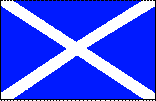
This article contains some notes on researching family history in Scotland, based on my personal experience and preferences.
The majority of my research in Scotland has been conducted through the use of the civil vital records held by the General Register Office, Scotland (GRO-Scotland), located in Edinburgh. Of all the civil records repositories I have searched, I consider the GRO-Scotland to be the easiest and most user friendly. The majority of the records held by the GRO-Scotland are available on-line, are indexed, and support web search access.
The records from the GRO-Scotland can be accessed by:
I would recommend accessing the Scotland's People site to become familiar with the records available. I have accessed the following types of records:
You must register to use the site (I do not think there is a fee to register). Additional records are being added to the site over time. There is a fee for searching this site based on the length of time of access and/or number of records accessed. The way it works is as follows:
You buy a 24-hour/30 "page" credit access for 6 British Pound Sterling (BPS), about $10 US, payable via credit card.
As you search and access records, you use up credits. The results of your searches are saved on the site, can be accessed later without having to pay an additional 6 BPS fee, and can also be downloaded to your PC in a spreadsheet format (I find the spreadsheet data very useful in that I can sort the data multiple ways to see if there are correlations on people).
Your ability to search the databases ends when 24 hours have passed or you have used up your 30 credits.
Please note that the 24-hour period is not "24 hours of access" (i.e. when you are logged into the site). The 24 hours is elapsed time (wall-clock time) from your time of purchase. If you purchase a 24-hour access at 12:01 p.m. on Sunday (lunch time), spend two hours searching and burn up 10 page credits in the process, and then logoff, your balance of 20 page credits will go away at 12:01 p.m. Monday. If you want to start searching again on Tuesday you will need to pay the 6 BPS fee again.
You can always add money to continue searching if you use up the first 30 page credits before the 24-hour time period expires. I normally use the 30-page credit in under 4 hours of access.
The record entries found here are normally single line entries, not images of the vital records. The exception to this is in the census records. Some of the census records are available online in full image format. Please note that if you access an image record, the cost in page credits is normally higher than a single record access. Image access can run about 5 page credits per image.
The type of data you will see after your search will include:
Type, Surname, Forename, Sex, Day, Month, Year, Father Surname, Father Forename, Mother Maiden Surname, Mother Forename, District, County, Miscellaneous, GRO1, GRO2, GRO3, GRO4, GRO5.
After I have located the records I want, the next step is to order copies of the original certificates from the GRO-Scotland, which can be done online. You will receive a certified copy (an exact image) of the record from the file. The exact image aspect is a very nice feature (I have not been able to get this from other GRO offices, as in Ireland). The records I have ordered contain original signatures from my ancestors, "X" signatures for those that are illiterate (good information to have!), etc. The cost of these copies runs about 10 BPS (about $16 US). The average time from order to document in my mailbox is about 2 to 3 weeks.
I normally treat a visit to the GRO-Scotland site in the same way I treat a visit to a distant library or repository. I try to itemize my targets, gather information I know about them so I can make informed decisions while searching. As with most search-enabled sites, it is easy to get lost on a tangential track before you get what you came for. My best/worst example of this for the GRO-Scotland site was in my search for my grandmother's brother. I was so sure that he was born in Glasgow, Scotland around 1896 that I kept expanding my search for him until I had way over 100 John McEwan's in my search results. After spending 60 page credits I went back and checked with some relatives here and in Scotland. Turns out the person I was looking for was born in Ireland, not Scotland.
When I plan for my "trip" to the GRO-Scotland web site I try to utilize the various free sites to narrow the scope of the search. One such site that I have found useful is http://www.scotsorigins. com/igi-search.aspx.
If you have an ancestor who died in military service you can search for them on the Commonwealth War Graves Commission at http://www.cwgc. org/. I was able to locate my grandmother's brother on this site (he was killed in the battle of the Somme). There is also some information on this site on obtaining a person's military records.
If you get to Scotland, I would recommend a visit to the Mitchell Library in Glasgow http://www. mitchelllibrary.org/ and http://www.glasgowlibraries. org/. There is a good collection of microfilm, maps, books, etc.
You may also find the following web sites useful:
Additional resources may be on the way. Based on conversations with family members in
Scotland, it is my understanding that the Catholic Church records for Scotland are being
digitized and configured for on-line access. I am not sure when the records will be
available, but I think it is in the 1 or 2 year range.

Isn't it great that we have access to so much genealogical material? We can get information from the web, from libraries, the National Archives, and we can send for copies of original documents from the military, courthouses, states, etc. Of course, much of the information we gather has to be taken as possibilities, rather than facts. But it does give us clues, places to look for further information. I like to travel to the sites to see things first hand.
Most small town libraries, museums and court houses are more than happy to help you find what you need.
There is something quite emotional about standing at an ancestor's grave, looking at the house where they lived and "walking in their footsteps."
For me, this was magnified many times when I went to England. I was able to stand in the church where my ancestors worshiped 400 years ago. I went to Powderham Castle in Sussex, which is still owned by a branch of my ancestral family. This castle was where they filmed the movie "Remains of the Day" starring Anthony Hopkins and Emma Thompson. It was given to an ancestress by her father and she willed it to her second son in only the second will ever registered in England. In the city of Sussex, I found all kinds of documents about the family, some written on parchment and some on sheepskin. They actually let me handle them!
But the real thrill came when I visited cathedrals. In Westminster, there is a tomb with statues of my ancestors lying on top of it. I visited Canterbury and saw a plaque about another relative who was the Archbishop of Canterbury. Then, I went to York Minster and found statues of two generations of ancestors! Imagine looking into the marble face of your ancestor!
When I went to Scotland, I researched in the General Records Office, but I found most of the information about the Kirkwood family in the local library in Kirkintilloch, where they lived. I was able to search the birth and death records to find all the families, then I went to the cemeteries (there were two, plus some graves beside the local church) and matched the names to the tombstones.
You don't have to go to another country to find such thrilling things. I have hunted down ancestor's graves in small, obscure cemeteries that are no longer used. Usually, finding these cemeteries gives me a really good idea of the countryside, so that I feel much closer to the ancestor by the time I find the grave. I found the homes my great-grandparents lived in, here in California, and in Oregon. Last summer, I found an old gas station that had been owned by my ancestors in Oregon - one of the earliest in the state.
So research is only half the fun of genealogy. You may be surprised at what you discover when you travel to the actual sites.

Many generations ago, my Havenor ancestors left Germany because of religious
persecution and settled in Ireland. My grandfather was born in County Galway in 1845. In
1848, the family left Ireland for the USA. As the story goes, my great-grandfather was
asked to leave, because, during the potato famine, he worked for the government in food
distribution and was accused of adding rocks to the potato sacks destined for the rich.
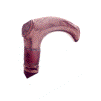 |
 |
Click on the image to enlarge the photo
Eventually, my grandfather, William Montgomery Havenor, moved west and was into mining
and railroading in California, Nevada and Utah. In 1874 he had a cane made for his father,
the handle of which is made of gold from the Comstock mines. On the head of the cane, the
inscription reads "Virginia, Nev." This was made before the town became Virginia
City, Nev. Of course my grandfather inherited it from his father and then it was passed on
to my uncle.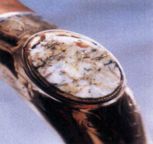
Sometime in the 1960s my mother and her remaining three siblings signed an agreement that the eldest male descendant of W. M. Havenor would have custody of this inscribed cane. For now, I am third in line, the last in my generation, and also the "keeper" of the decendancy list which I'm sure you all realize, grows in ever increasing numbers. By the time the list becomes unmanageable, I don't think I'll have to worry about it!
About 10 years ago, one of the female members suggested that there should be an object for the females to pass down through the ages. A female cousin was in possession of a brooch hand-painted by William's wife, Sarah, and this piece of jewelry became the female equivalent of the males' cane.
As a sidebar, my grandfather served one term in the Nevada state legislature in the
l880s and co-sponsored a bill to give women the right to vote. The bill was soundly
defeated! This is documented in the legislative archives of the Nevada State Library.

Editor's Note: Gary Drummond has long been a student of Livermore Valley History. He is the author and editor of several publications on Valley history, including the stories of Mary Ann Harlan Smith, William Mendenhall and James D. Smith, Headmaster of Livermore College from 1875 to 1893. He is on the Board of Directors of the Livermore Heritage Guild.
On February 16, 1850, a young minister and his bride left Crawfordsville, Indiana, traveled up the Ohio river and across Pennsylvania to New York, where they arrived on the 23rd. This young man was William Wallace Brier; his wife was Elizabeth Brier. They were bound for California under the auspices of the American Home Missionary Society, who managed both Presbyterian and Congregational Church missionaries.
The couple was delayed in their departure from New York until May 2. They reached Chagres, Panama ten days later. After crossing the isthmus they reached the Pacific shores to find 3,000 people awaiting transportation to San Francisco. It was not until July 18 that they could secure passage up the coast. During the over two months delay, Brier wrote home that he had "preached every Sabbath since the first. I have had large congregations as could be accommodated, sitting and standing."
The Briers arrived in California to learn that he had been assigned to establish a church in Marysville. He left his pregnant wife at Mission San Jose with relatives, and, in his letters to his wife, noted, "On the 8th of September I preached my first sermon in this place. All the stores were open and business was as on weekdays. I stood under an oak tree in the Plaza while I sang an old sacred song (of 'camp meeting' origin), many came running from every quarter to hear what was up."
Mrs. Brier, in her reminiscences written fifty years later, commented, "A lot had been given us in Marysville. Mr. Brier, with the help of a cheap car-penter ($10 to $16 a day was the usual price) had
built a house, the dimensions of which were 10 x 20 feet. It was not finished when I went into it. We could see the stars through the cracks. But when it was lined in calico, it was very cozy. We had a partition of calico to make two rooms. Mr. B. made a bedstead and a lounge. The top had hinges. It was the only closet we had. It served as a spare bed frequently. Two rooms were added the following year. There were more cloth tents in the town than wooden houses. So we were quite swell."
She continued: "Services were held in the Court House. Women were few. Our Elder used to say that he came to church to see the baby as much as to hear the sermon. Ours was the first in town. Men have stopped by our door and with streaming eyes say 'I would like to see the baby. I left one at home'."
Rev. Brier worked tirelessly to solicit funds to construct a Presbyterian Church in Marysville. He raised about $6,000 within the community, even going to mining camps on foot, where he would preach and take up an offering, raising several hundred dollars that way.
Brier's health had been poor since an attack of chagres fever in Panama. He found the summer heat in Marysville almost unbearable, and subsequently asked to be relieved.
He and his family returned to the Bay Area, settling in the village of Centerville, building one of the first homes there. He continued his missionary work, organizing a Presbyterian Church in Centerville in June, 1853. Over the next twenty years Brier organized Presbyterian Churches in Alvarado, Livermore (1871), Pleasanton (1876), Milpitas, and in 1860, organized a congregation in Red Bluff. That same year (1860), Brier was appointed Superintendent of Missions for Nevada where he founded the church in Carson City in 1861, the oldest Presbyterian Church in that state, and the church in Virginia City in 1862. In all, he organized at least ten churches in California and Nevada. In the mid-1860s he served as Alameda County Superintendent of Schools.
William Wallace Brier died on June 3, 1887, 66 years old, and is buried in the cemetery
which surrounds the First Presbyterian Church in Centerville.

By Jon Bryan
From The Livermore Herald on January 19, 1901:
Scalded in a Vat of Boiling Malt. His Foot Evidently Slipped While Cleaning a Tank Above and He Fell to His Death.
One of the most terrible accidents that has ever occurred in Livermore, deprived the town on Thursday of one of its most respected citizens, Wendell Jordan.
Mr. Jordan was a brewer by occupation and had been accustomed always to give personal attention to the details of his business. Thursday forenoon he was engaged in brewing with his assistant, Carl Granitz, and had set the malt to cooking. While it was boiling Mr. Jordan started to clean out a small tank situated above and to one side of the vat. About this time Granitz stepped out of the room to get a drink of water. As he was returning he heard a stifled cry and splash and hastened in to find that his employer had fallen into the seething cauldron. Whether his foot slipped or whether he had an attack of vertigo will never be known.
Granitz rushed to the street and summoned assistance. He then, turned the faucet and drained off the boiling mass. While it was slowly flowing out, T. E. Knox, F. Thompson and others started in to rescue the body. This was done with much labor and inconvenience, Mr. Thompson scalding his hands severely in the work. When the unfortunate man was laid on the platform he gave a final gasp and expired.
The flesh was literally cooked and the features were so badly disfigured as to be unrecognizable. Although death was not instantaneous it is likely that the fatal plunge was not attended by any suffering as he must have become unconscious the moment he came in contact with the boiling malt as he evidently struck head first.
Although Mrs. Jordan was in her rooms in the second story of the building, she knew nothing of the awful affair until some time after the body was recovered. She was prostrated over the dread tidings as was her daughter, Miss Ada, when brought from school and told as gently as possibly that she had been so suddenly and awfully bereft of an idolized father.
Funeral services will be held at Masonic hall today (Saturday) at 3 PM under the auspices of Mosaic Lodge, No. 218, F. and A. M. The remains will be taken to San Francisco Sunday morning where they will be cremated at the Odd Fellows Crematory. A delegation of members of Mosaic Lodge will accompany the remains.
Wendell Jordan was born in Germany in 1837. He came to the United States alone when he was a lad of only seventeen. Nothing daunted by his youth and inexperience, Mr. Jordan started to carve out his fortune in a strange land, with the language and customs of which he was not in the least familiar, and without either friends or money. He located first in Louisville, where he remained for several years. During the Civil War he returned to Germany and remained until business again became settled in 1865. He then went to Idaho where he engaged in mining for several years. After this he was engaged in business in Oregon for a short time. He came to Livermore in 1874 and engaged at once in the brewing business. He was a good business man, industrious and painstaking and he built up a large business.
Mr. Jordan was an unusually public spirited citizen. He was one of the organizers of the Livermore Fire Department and was a foreman for over twenty years. He also served the town as a Trustee for several terms and was chairman of the Board for two years. He was as careful in administering the affairs of the town as he was in conducting his own business and retired to private life enjoying the confidence and esteem of the whole community.
Deceased was a member of the Masons, Odd Fellows and Hermann Sons.
Mr. Jordan was known as a very charitable man. He was never to resist an appeal for aid when the case was deserving and he was ever foremost in all contributions to public enterprises having for their object the betterment of the town, industrially or socially.
If is doubtful if a person ever died in Livermore who will be more universally regretted than Mr. Jordan. If he had an enemy in the community we never heard of it. The expressions on all sides indicate that the town has sustained a loss in the death of this worthy man which will never be replaced.

Thanks to the efforts of Doug Mumma, Vicki Renz, Mildred Kirkwood and Debbie Pizzato over the last six years, past issues of The Roots Tracer since 1996 are available on our Web site for the world to read. You can view them by surfing to http://www.L-AGS.org, then clicking on the link "The Roots Tracer." Not only are all of the words of the printed versions available by the click of a mouse, but the graphics are all in color - something that is prohibitive in cost to do in the paper issues. Most important - all of the words in all of the issues are hittable by the site-wide search engine on our home page. For example, if you vaguely remember reading about local Mexican land grants, you can put in "land grants" and quickly arrive at Gary Drummond's article in July 1997.
In 1988, in honor of the 10th anniversary of the founding of the Roots Tracer, L-AGS published an index to all of the issues up until then. It is called "Ten-Year Cumulative Every-Name Index and Index to Major Subjects for the Livermore Roots Tracer." It is still in print and is in major genealogical libraries. Late last year this index was also published on our Web site. The link to it is on the same "The Roots Tracer" page cited above.
Since 2003 marks the 25th anniversary of the Tracer, we decided to complete the "Webizing" process for our venerable journal. The digital files for issues from 1992 to 1996 were still in existence, so these were converted to Web language and posted, again on the same page mentioned above. Some compromise was required to keep the conversion effort within reason - all of the words and all of the non-decorative graphics were preserved, and thus are searchable, but the attractive formatting was sacrificed in favor of a plain vanilla, easy-to-convert style.
The final gap to be filled are the issues from 1988 to 1992. David Abrahams is heading up a project to develop an index for these years. He will write about that project in a future Roots Tracer. He and his wife, Jolene, the L-AGS Historian, are also preparing to honor the 25 years of hard work that our editors have put in by binding a set of the paper copies of the Tracer into high quality hard covers. These will be available for reference use in our collection at the Pleasanton Library. David and Jolene will also describe this effort in a future Tracer.
If you think that archives must be as exciting as a snail race, try browsing the old
issues. I did that by picking February 2000 at random on the "Tracer Archives"
page. What I found was useful and delightful - how to do genealogy on eBay, a wonderful
story about "Five Hundred Thanks," and more. Try it - you'll gain new respect
for our Society and its public face, The Roots Tracer.

If you, or someone you know, has lost medals for service in the United States Army, you should write to the following address:
US Army Reserve Personnel Center
Attn: DARP-PAS-EAW
9700 Page Blvd.
St. Louis, MO 63132-5200
Include the veteran's full name, address, place of induction, serial number, date and place of birth, dates served in the Army, and copy of separation document, DD214. Veterans of other services may obtain addresses from their Congressman.
FROM: Bobby Spurgin, North San Diego County Genealogical Society, Vol. XXXII, #9, October, 2002.
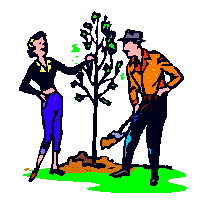
(Genealogy Resources On the Web - The Page That Helps Genealogy Grow!)
Compiled by Frank Geasa
This Depauw University site contains several excellent online search lists including census indexes of Putnam County, Indiana; the ministers of several Methodist associated denominations and a list of the inductees to the Indiana Journalism Hall of Fame. http://www.depauw.edu/library/archives
If you have a relative who was in the Alaskan Gold Rush 1896-1914, check this Alaska State Library site. Guidance and links to repositories of vital records, genealogy societies and other collections of genealogical data, some with online search lists.
http://www.library.state.ak.us/hist/parham.html
The America's First Families site is dedicated to the genealogy of families in America in the 1600s. If that doesn't include your ancestors, do not fake it. The site also provides interesting exposures of past attempts at fraudulent genealogy.
http://www.linkline.com/personal/xymox/#ROH
If you happen to have roots in the west of County Cork, Ireland you can search the names listed in the Griffiths Valuation (1848-51) at this site.
This Old Buncombe County Genealogical Society Site has many online search lists for that area of North Carolina. These include lists of marriages, bible and cemetery records, Revolutionary War pensions and several other categories of data.
Perhaps a reflection of the times, this site charges to put an obituary on line. Searching their growing worldwide database, however, is free.
http://www.obituariesonthenet.com/
If your ancestry includes Alabama roots you will want to visit this excellent site created by Lisa R. Franklin. It has many search lists organized by county, as well as some Civil War lists and some lists of west Florida records.
http://www.trackingyourroots.com/
The USGenexchange site allows on-line searching of everything from birth and death to military records. Much of the data is organized by county & state (click Public Records) although some data is organized by topic. http://www.genexchange.org/us.cfm
If your ancestors were from West Virginia during the period of the Civil War or you are a Civil War Buff, Linda Fluharty has created a site well worth visiting. http://www.lindapages.com/cwlist.htm
The Alexandria, Virginia Library has an online search list of World War I draft registrants from Alexandria (now Arlington) and Fairfax Counties.
http://www.alexandria.lib.va.us/lhsc_genealogy_resources/draft/ww1draft.html
You will find many unique search lists through this site that has links to numerous vital records databases. While not all the lists are free, many are and the variety warrants a visit.
http://www.awesomegenealogy.com/
The Secretary of State site for Washington State allows online search of the 1851 Lewis County, 1860 Federal (partial) and 1871 Yakima County censuses.
http://www.secstate.wa.gov/history/search.aspx
The World War 2 Nominal Roll site offers a search list of some 1 million names of Australians who served in that war. http://www.ww2roll.gov.au/
City Directories for Gogebic County, Michigan and Iron County, Wisconsin are online at this site. It also includes some historical and family information. http://mattsonworks.com/index.html?row1col2=shareyzedek.html
A 1787 city directory for Glasgow, Scotland is at
http://www.amostcuriousmurder.com/Jones.htm
Search 45 Million used books world wide at http://www.2ndhand.org.uk/cgi/books.cgi

A Quick Tip! From Bernice Bronieki from the Ancestry.com e-mail newsletter.
Whenever I update my genealogy software program with any new information regarding my ancestors, I also make an abbreviated notation of any additions to a simple spreadsheet. In the first column, I put the date - year first, then month and day (1845/04/15). The second column contains a brief description of the event and those involved. Next, I check Web sites of local historical societies and others such as dMarie Time Capsule (http://dmarie.com/timecap/step1.asp) to learn what was being reported in the news on or around the same date as my listed event. I then add any noteworthy headlines, along with the dates, in another column of the spreadsheet. Finally, I sort the information beginning with the most recent date.
Now I can look at my spreadsheet and instantly see what events were taking place on either side of the family and how the road was being paved for future interaction among the different branches. Also, I can see at a glance which world and local events were impacting the lives of my ancestors. Our city had a great fire in April 1845. Until I began this tracking method, I wasn't aware that within a week of the fire, Swiss families from my ancestors' canton arrived here and settled directly across the river from the affected area. I can only imagine what an impression such a tragic sight made upon them.
The Barnes & Noble web site http://www.barnesandnoble.com has a section called Online Courses. Clicking that link takes you to Barnes & Noble University where they list free and tuition-based courses in several categories. One of particular interest to us is "Unpuzzling Your Past," created and led by Emily Croom, who wrote the book by the same title. The course is described as taking 16 hours to complete over a four-week session. To enroll in this free, online, instructor-led course, choose the Life Improvement category, then scroll down to "Unpuzzling Your Past." The course outline is very comprehensive and the instructor is involved in the class through postings on message boards.
Another site that has free on-line courses in genealogy research is Brigham Young University http://www.byu.edu. Click on Courses Online on the left side of the page, then Independent Study, then Free Web Courses, then Family History. You can choose from three courses, all for beginners: Introduction to Family History Research, Finding Your Ancestors, or Providing Temple Ordinances for Your Ancestors. They are interactive and fun to do, even if you are an experienced researcher. It just feels good to answer the questions and get them right!
While experimenting with these sites, I became curious about other on-line genealogy courses, so I went to Cyndi's List http://www.cyndislist.com and found several other sites that have courses or guides to research:
Even though these sites may seem to be for beginners to family history, just going through a course may help an experienced researcher break through a brick wall. The courses may be a reminder of a type of record that had been forgotten or one that hadn't been used yet in searching for missing information.
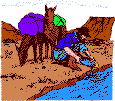
Transcriber: Wilma Pease Myers
The continued memoir of Charles A. Bayley's life on Vancouver Island
in 1851.
Transcribed by Wilma P. Myers, August 2002
Between these two events gold was discovered on Q. C. Island by the Indians, who not knowing that it had any intrinsic value beyond making bullets to which use they converted it for killing Game. It by chance came to the knowledge of the H.B.Co.(Hudson's Bay Company) that they were doing so. Encouraging them to procure more they traded for leaden bullets which saved them the labor of making them.
The country being inhabited by the Hydah's, a fierce tribe, it was easier for the H.B.Co. to let the natives bring the Gold, than risk the lives of their men in getting it, until the adventurous spirit of the Pacific Coast Miner was aroused it remained in the possession of the Indians and the H.B.Co. till 1852, when the first expedition was started from Vancouver Island which ended with poor results for the explorers, on account of the hostility of the Natives. The cupidity of the Natives was easily excited in those days of savagery by the surface wealth of the whites. The difference between their mode of extracting gold and the American mode as the knowledge of blasting was unknown to them, as they built a fire on the rock and when sufficiently heated poured water on it and caused it to break, then by pounding it made the required shape as a bullet.
Other expeditions followed from San Francisco in 1859, with but poor results as no gold could be obtained below the surface. The Indians being the stronger party at the first expedition, after the first blast was put in, rushed in with their knives in hand and a scramble took place for the result of the blast and the lion share went to the knives.
The excitement of the Gold fever died away and only occasional visits in search of Gold made by small parties with no profit.
In about 1860, coal of a superior quality was discovered on the Island and a large
quantity of coal taken out but not sufficient to compensate for the outlay owing to the
trouble that presented itself from upheavals caused by Volcanic action has prevented it
being worked profitably.
The "Tory" took up machinery and men to work the coal discovered at Fort Rupert at the North end of the Island, which the Indians had opened up by shipping the surface earth off, and supplied the Blacksmith shop and steamers with of the H.B.Co. but it was found to be such an inferior quality that it was abandoned and the whole of the material removed to Nanaimo.
The Vancouver Coal Company was formed of the Officers of the H.B. Company and a manager, Mr. Gilmour, with miners sent out from Scotland to work the coal which proved a success as the coal is the best found on the Pacific Coast. Nanaimo is a town of increasing prosperity. The Wellington Coal of recent discovery adding materially to it and many other discoveries of a like nature having been made recently. The Sandstone formation of which the Mint of San Francisco is built shows its quality and will be at some future time a source of profit.
At the time the "Tory" went to Fort Rupert Capt. Wm Brotchie was engaged cutting spars for the French Government many of which were not shipped and proved a loss.
The Island is very narrow in this part a Trail having been cut through to Quatseem by Mr. A. Hunter in search of coal, when it was found out that the seam would not pay to work. Mr .George Blenkinsop was the officer in charge at that time and exerted himself to find coal to build up the place but without success. The Indians reaped the benefit of his labors as it provided them with a good road in the Berry season to cross the Island to the Ocean and carry their goods to a Trading post.
Marble has been discovered on Tacada Island in the Gulf of Georgia and is being prospected.
Magnetic Iron ore of a superior quality has also been found.
Pine forests of the best quality extending inland many miles contributes its share to
the general wealth of the neighborhood as the Saw Mills give employment to a great many
hands.
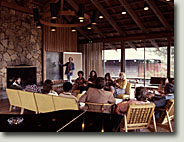
By Marie Ross
February 22, Whittier, CA - 21st Annual Seminar, Katherine Scott Sturtevant speaker, Whittier Masonic Lodge. http://www.cagenweb.com/~kr/wags
March 8, Sacramento, CA - Family History Day at the Archives, 1020 'O' St.. Research resources, computer demonstrations, preservation techniques, genealogy and historical mini-classes. Free. Information: ijones@accessbee.com or http://www.ss.ca.gov/archives/archives.htm
March 15, San Mateo, CA - San Mateo County Genealogical Society Seminar, Irish genealogy by Nora Hickey of County Cork, Ireland, 1st Presbyterian Church, 25th & Hacienda 9 am to 4 pm. CathT@aol.com
March 23, Santa Rosa CA - Sonoma County Genealogical Society Seminar, Sharon DeBartolo Carmack speaker, at Sonoma State University. http://www.rootsweb.com/~cascgs/carmack.htm
March 29-30, Asilomar, CA - New England Historical Genealogical Society Conference, hosted by CA Genealogical Society , Asilomar Conference Center, http://www.asilomarcenter.com/
April 5, Carmichael, CA - Annual Spring Seminar of the Sacramento German Genealogy Society at the La Sierra Community Center, 5325 Engle Rd. Roger Minert, speaker. Information: Victor Boisseree, 916-482-8511 or boisseree3@aol.com
April 12, Sacramento, CA - Roots Cellar/ Sacramento Genealogical Society Seminar, with Barbara Renick.
April 24-26, Salt Lake City, UT - Utah Genealogical Association, Conference, "Family History: the Drama and the Dreams." http://www.infouga.org/confrnce.htm
May-26-June2, Pittsburgh, PA, NCGS Conference, Information at (703) 525-0050 or http://www.ngsgenealogy.org
Sepember 3-6, Orlando, FL, Federation of Genealogical Societies Conference, "A World of Hidden Treasures." http://www.fgs.org/
October 11, Auburn, CA - Placer County Genealogical Society Annual Seminar. Details to be announced.
October 12, Los Angeles, CA - Genealogical Society for Hispanic Americans will hold their annual Fiesta in conjunction with the Mexican Cultural Institute at Olivera Street.
October 18, San Francisco Bay Area - California State Genealogical Association Annual Meeting. Details to be announced.
October 18, Foster City, CA - San Francisco Bay Area Genealogical Consortium Conference, focusing on California research and ethnicities, will also offer lectures and workshops in preservation and beginning research. Crowne Plaza in Foster City. CathT@aol.com
November 8, Livermore, CA - L-AGS Seminar. Details to be announced.
The National Genealogical Society recently began an e-mail publication called UpFront with NGS. It is full of educational articles, tips and event information. And, it is free.
If you are interested in subscribing, send an e-mail message to NGS-L-request@rootsweb.com.
Type the word "subscribe" in the body of the e-mail. If your e-mail program requires a subject you can type subscribe there as well.
To learn more about the goals, publications, conferences, services and member benefits of NGS, visit the NGS web site http://www.NGSgenealogy.org.
From Santa Clara County Historical and Genealogical Society, Vol. 47, No. 9, October 2002.
| Editors | Mildred Kirkwood Debbie Pizzato |
|
| Proofreading | George Anderson Cassie Wood Vicki Renz |
|
| Printing/Distribution | Eileen Redman | |
| Staff Contributors | ||
| Computer Interest Group | Jim Lathrop | |
Family Tree Maker Group |
Dick Finn | |
Livermore History |
Gary Drummond | |
| G.R.O.W | Frank Geasa | |
| Life in the Past Lane | Jon Bryan | |
| Study Group | Kay Speaks | |
Seminars and Workshops |
Kaye Strickland | |
| Things to File | Vicki Renz | |
| Library News | Judy Person | |
| Tri-Valley TMG User Group | Kay Speaks |
[ Roots Tracer Menu ] [ L-AGS Home Page ]
Last modified 22 June 2003 vlr, 21mar05.1047 gwa